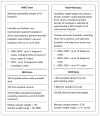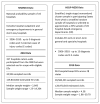Comparability of national estimates for traumatic brain injury-related medical encounters
- PMID: 25955702
- PMCID: PMC4677327
- DOI: 10.1097/HTR.0000000000000105
Comparability of national estimates for traumatic brain injury-related medical encounters
Abstract
Objective: To describe similarities and differences in the number of civilian traumatic brain injury (TBI)-related hospitalizations and emergency department visits between national databases that capture US hospital data.
Participants: TBI-related hospitalizations included in the National Hospital Discharge Survey (NHDS) and Healthcare Cost and Utilization Project Nationwide Inpatient Sample (HCUP-NIS) and emergency department visits in the National Hospital Ambulatory Medical Care Survey (NHAMCS) and HCUP Nationwide Emergency Department Sample (HCUP-NEDS) for 2006-2010.
Design: Cross-sectional design.
Main measures: Nationwide counts of TBI-related medical encounters.
Results: Overall, the frequency of TBI is comparable when comparing NHDS with HCUP-NIS and NHAMCS with HCUP-NEDS. However, annual counts in both NHDS and NHAMCS are consistently unstable when examined in smaller subgroups, such as by age group and injury mechanism. Injury mechanism is consistently missing from many more records in NHDS compared with HCUP-NIS.
Conclusion: Given the large sample size of HCUP-NIS and HCUP-NEDS, these data can offer a valuable resource for examining TBI-related hospitalization and emergency department visits, especially by subgroup. These data hold promise for future examinations of annual TBI counts, but ongoing comparisons with national probability samples will be necessary to ensure that HCUP continues to track with estimates from these data.
Conflict of interest statement
The authors declare no conflicts of interest.
Figures




References
-
- Faul M, Xu L, Wald MM, Coronado VG. Traumatic Brain Injury in the United States: Emergency Department Visits, Hospitalizations, and Deaths 2002–2006. Atlanta, GA: Centers for Disease Control and Prevention, National Center for Injury Prevention and Control; 2010.
-
- Langlois J, Rutland-Brown W, Thomas K. Traumatic Brain Injury in the United States: Emergency Department Visits, Hospitalizations, and Deaths. Atlanta, GA: Centers for Disease Control and Prevention, National Center for Injury Prevention and Control; 2006.
-
- Coronado VG, McGuire LC, Sarmiento K, et al. Trends in traumatic brain injury in the U.S. and the public health response: 1995–2009. J Safety Res. 2012;43(4):299–307. - PubMed
-
- Marr A, Coronado V, editors. Central Nervous System Injury Surveillance Data Submission Standards—2002. Atlanta, GA: Centers for Disease Control and Prevention, National Center for Injury Prevention and Control; 2004.
-
- Centers for Disease Control and Prevention. Recommended framework for presenting injury mortality data. MMWR Morb Mortal Wkly Rep. 1997;46(RR-14):1–30. - PubMed
MeSH terms
Grants and funding
LinkOut - more resources
Full Text Sources

